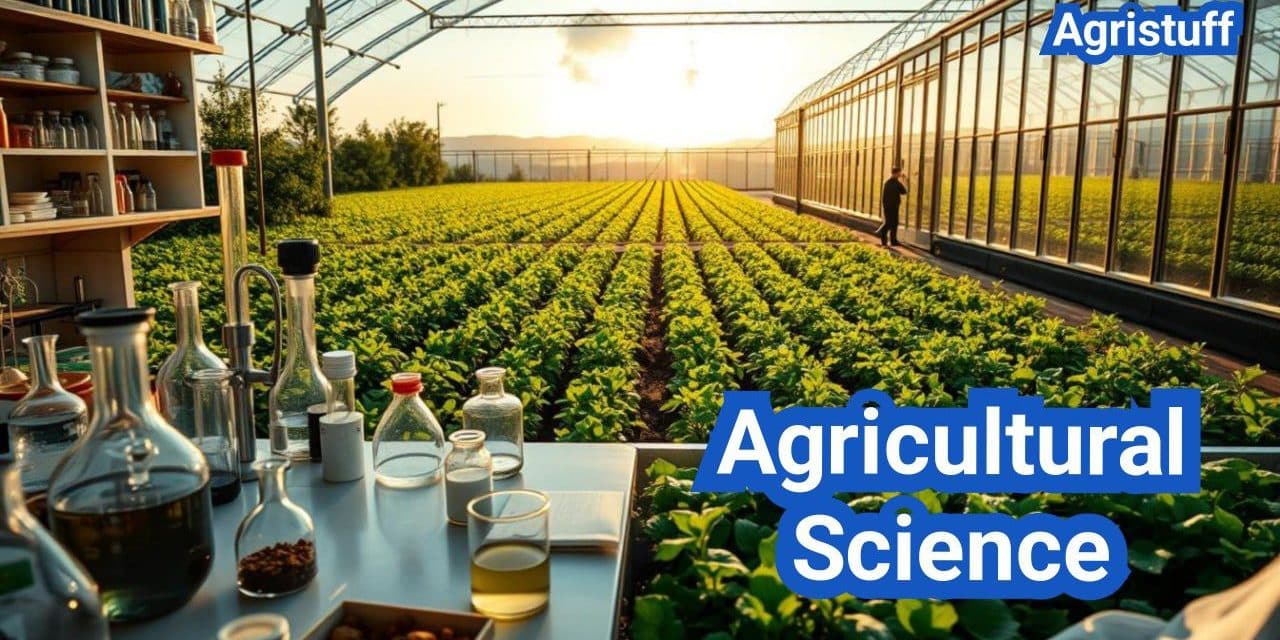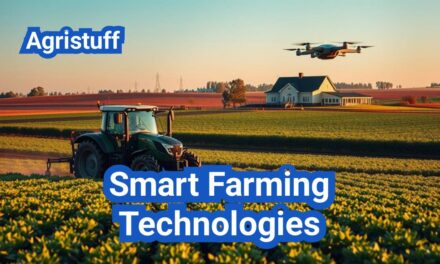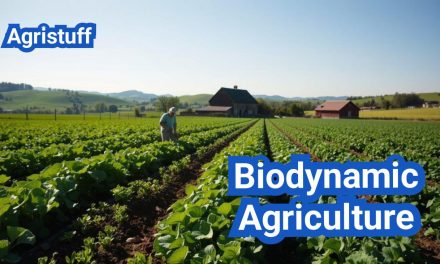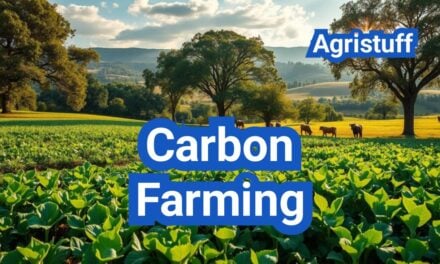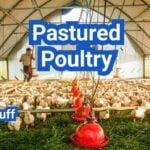Agricultural science is a vital field that encompasses various disciplines related to food and fibre production and processing.
It involves soil cultivation, crop cultivation, animal production, and processing of plant and animal products, playing a crucial role in the global food supply.
Universities offering agriculture majors and agricultural science degree programs equip students with the knowledge and skills necessary to succeed in this field.
Key Takeaways
- Agricultural science is a multidisciplinary field.
- It involves various disciplines, including soil and crop cultivation.
- Agricultural science is crucial for the global food supply.
- Universities offer programs in agricultural science.
- Graduates can pursue careers in agriculture and related fields.
Understanding Agricultural Science
Understanding agricultural science is crucial for addressing global food security challenges and promoting sustainable farming. Agricultural science, at its core, is about applying scientific knowledge to improve agricultural practices.
Definition and Fundamental Concepts
Agricultural science is defined as the science or occupation of farming, including the cultivation of crops and the raising of livestock. It encompasses a broad range of disciplines, including biology, chemistry, physics, and earth sciences, to understand and improve agricultural practices.
The fundamental concepts of agricultural science involve understanding the biological, chemical, and physical processes that affect agricultural productivity. This includes knowledge of soil science, plant breeding, animal husbandry, and agricultural ecology.
The Relationship Between Science and Agriculture
Science plays a vital role in agriculture, enabling farmers to make informed decisions and improve productivity. The application of scientific principles in agriculture has led to significant advancements in farming practices, such as the development of high-yielding crop varieties and more efficient irrigation systems.
The integration of science into agriculture has also facilitated the adoption of sustainable farming practices, reducing the environmental impact of farming while maintaining productivity.
Why Agricultural Science Matters Today
Agricultural science is more important than ever today, as the global population continues to grow and the challenges of climate change, soil degradation, and water scarcity intensify. Agricultural science can help address these challenges by developing and promoting practices that enhance productivity, sustainability, and resilience in agriculture.
| Key Areas | Impact on Agriculture | Benefits |
|---|---|---|
| Crop Science and Plant Breeding | Improved crop yields and disease resistance | Enhanced food security and reduced pesticide use |
| Soil Science and Conservation | Better soil health and reduced erosion | Increased fertility and reduced environmental impact |
| Agricultural Technology | Precision farming and efficient resource use | Reduced waste and improved productivity |
By understanding and applying agricultural science, we can develop more sustainable and productive farming systems, ultimately contributing to global food security and environmental sustainability.
The Historical Evolution of Agricultural Science

The history of agricultural science is a rich tapestry woven with discoveries and innovations that have transformed farming practices over centuries. Understanding this evolution provides valuable insights into how agricultural practices have adapted to meet the world’s changing food needs.
Ancient Agricultural Practices and Knowledge
Ancient civilizations laid the foundation for modern agricultural science through their observations, experiments, and innovations. Early farmers developed techniques such as crop rotation and irrigation, which significantly improved agricultural productivity. For instance, the ancient Egyptians used the Nile’s floodwaters to fertilize their land, while the Chinese developed sophisticated irrigation systems.
The Agricultural Revolution and Scientific Farming
The Agricultural Revolution marked a significant turning point in the history of agricultural science. This period saw the introduction of new farming techniques and tools, such as the steel plow, which enabled deeper tillage and improved soil fertility. The revolution led to increased food production and had a profound impact on population growth and societal development.
The advent of scientific farming further transformed agriculture by applying scientific principles to farming practices. This included the use of fertilizers, improved crop varieties, and more efficient farming techniques. The work of pioneers like Gregor Mendel, who discovered the fundamental laws of inheritance, laid the groundwork for modern plant breeding.
20th Century Advancements in Agricultural Science
The 20th century witnessed tremendous advancements in agricultural science, driven by technological innovations and scientific discoveries. The Green Revolution, led by figures like Norman Borlaug, introduced high-yielding crop varieties and intensive farming practices, significantly boosting global food production. Advances in agricultural machinery, irrigation systems, and the use of synthetic fertilizers and pesticides further increased efficiency and productivity.
The development of biotechnology and genetic engineering opened new avenues for improving crop yields and disease resistance. These technologies have enabled the creation of crops that are more resilient to environmental stresses and pests, contributing to global food security.
Recent Developments and Future Directions
In recent years, agricultural science has continued to evolve with the integration of digital technologies, precision farming, and sustainable practices. The use of drones, satellite imaging, and data analytics has enhanced farm management and decision-making. There is also a growing emphasis on sustainable agriculture, focusing on practices that minimize environmental impact while maintaining productivity.
Looking to the future, agricultural science is poised to address the challenges of climate change, population growth, and food security. Innovations in gene editing, vertical farming, and agroecology are expected to play crucial roles in shaping the future of agriculture. As the world grapples with these challenges, the historical evolution of agricultural science provides a foundation for understanding the potential pathways forward.
Core Disciplines of Agricultural Science
Understanding agricultural science requires a deep dive into its core disciplines, which form the backbone of the field. These disciplines are interconnected and crucial for addressing the complex challenges faced by modern agriculture.
Crop Science and Plant Breeding
Crop science and plant breeding are fundamental to improving crop yields, disease resistance, and nutritional content. Advances in these areas have led to the development of high-yielding crop varieties that can thrive in challenging environmental conditions.
The use of modern breeding techniques, such as marker-assisted selection and genomic editing, has revolutionized crop improvement. These technologies enable scientists to introduce desirable traits into crops more efficiently and accurately than traditional breeding methods.
“The development of crops that are resilient to environmental stresses and have enhanced nutritional profiles is critical for ensuring global food security.” – Dr. Jane Smith, Crop Scientist
Animal Sciences and Livestock Management
Animal sciences and livestock management focus on improving the health, productivity, and welfare of farm animals. This includes the development of sustainable feeding practices, disease control measures, and breeding programs tailored to different production systems.
| Aspect | Description | Benefits |
|---|---|---|
| Nutrition | Optimized feeding strategies | Improved growth rates, reduced environmental impact |
| Health | Disease prevention and control | Reduced antibiotic use, improved animal welfare |
| Genetics | Selective breeding programs | Enhanced productivity, disease resistance |
Soil Science and Environmental Management
Soil science is critical for understanding soil health, fertility, and conservation. Effective soil management practices are essential for maintaining soil productivity and minimizing environmental degradation.
Environmental management in agriculture involves strategies to reduce the environmental footprint of farming practices, including water conservation, reduction of chemical inputs, and promotion of biodiversity.
Agricultural Engineering and Technology
Agricultural engineering applies technological innovations to improve agricultural productivity and efficiency. This includes the development of precision agriculture techniques, automated farming systems, and machinery designed to reduce labor and environmental impact.
The integration of technology in agriculture has transformed farming practices, enabling more precise and efficient use of resources. Technologies such as drones, satellite imaging, and IoT devices are being used to monitor crop health, detect issues early, and optimize inputs.
Key technologies include:
- Precision irrigation systems
- Automated farming equipment
- Data analytics for decision-making
Specialized Fields Within Agricultural Science

Within agricultural science, there are numerous specialized fields that contribute to its richness. These fields are crucial for addressing the complex challenges faced by the agricultural sector, from food production to environmental sustainability.
Food Science and Technology
Food science and technology play a vital role in ensuring the quality and safety of food products. This field involves the application of scientific principles to understand the physical, biological, and chemical properties of food. Key areas of focus include food processing, preservation, and packaging.
- Improving food texture and flavor
- Developing new food products
- Enhancing food safety through microbiological control
Advances in food technology have led to the development of innovative products and processes that meet consumer demands for healthier, more sustainable food options.
Agricultural Economics and Business
Agricultural economics and business management are essential for the economic viability of farming and related industries. This field encompasses the study of economic principles, business management, and marketing strategies specific to agricultural production and distribution.
Economic analysis is used to understand market trends, optimize resource allocation, and predict future agricultural commodity prices. Effective business management practices help farmers and agricultural businesses to remain competitive in a global market.
Forestry and Natural Resource Management
Forestry and natural resource management are critical for maintaining ecological balance and ensuring the long-term sustainability of natural resources. These fields involve the management of forests, water resources, and land to provide ecosystem services and products.
Key practices include:
- Sustainable forestry practices
- Wildlife conservation
- Soil conservation techniques
Agricultural Biotechnology
Agricultural biotechnology involves the use of biological systems or living organisms to develop new products and technologies. This field has the potential to improve crop yields, enhance nutritional content, and develop pest-resistant varieties.
Applications of agricultural biotechnology include the development of genetically modified organisms (GMOs) and the use of microbial biotechnology to improve soil health.
By exploring these specialized fields within agricultural science, we can better understand the complexity and diversity of the agricultural sector and its contributions to global food security and sustainability.
How to Choose the Right Agricultural Science Degree
With numerous agricultural science programs available, selecting the one that aligns with your career goals is essential. The agricultural science sector is diverse, encompassing various disciplines that cater to different interests and professional aspirations.
Assessing Your Career Goals and Interests
The first step in choosing the right agricultural science degree is to assess your career goals and interests. Consider what aspects of agricultural science appeal to you the most. Are you interested in crop science, animal husbandry, or perhaps sustainable agricultural practices? Reflecting on your career aspirations will help narrow down the degree options that best suit your needs.
- Identify your areas of interest within agricultural science.
- Research career paths related to your interests.
- Consider the skills and knowledge required for your desired career.
Types of Agricultural Science Degrees Available
Agricultural science encompasses a broad range of degree programs, each with its unique focus and specializations. Some of the common types of degrees include:
- Bachelor of Science in Agriculture
- Bachelor of Science in Agricultural Science
- Bachelor of Science in Environmental Science with a focus on agriculture
- Specialized degrees in areas like agricultural engineering, animal science, or crop science.
Comparing Program Curricula and Specializations
Once you have identified the types of degrees that align with your career goals, it’s crucial to compare the program curricula and specializations offered by different institutions. Look for programs that offer:
- Relevant coursework that aligns with your career interests.
- Specializations or electives that allow you to deepen your knowledge in specific areas.
- Research opportunities or practical experiences that can enhance your learning.
Evaluating Program Resources and Facilities
The quality of resources and facilities available can significantly impact your learning experience. When evaluating agricultural science programs, consider the following:
- The availability of state-of-the-art laboratories and equipment.
- Access to experimental farms or research centers.
- Industry connections and opportunities for internships or job placements.
By carefully assessing your career goals, exploring the types of agricultural science degrees available, comparing program curricula, and evaluating program resources, you can make an informed decision that sets you on the path to a successful career in agricultural science.
Bachelor’s Degree in Agriculture: A Comprehensive Guide

Pursuing a bachelor’s degree in agriculture can be a rewarding career choice for those passionate about farming and agricultural science. This degree program is designed to provide students with a comprehensive understanding of agricultural principles, practices, and technologies.
Admission Requirements and Prerequisites
To be eligible for a bachelor’s degree in agriculture, students typically need to meet specific admission requirements. These may include:
- A high school diploma or equivalent
- Minimum GPA requirements
- Completion of prerequisite courses such as biology, chemistry, and mathematics
- Standardized test scores (SAT or ACT)
Some institutions may also require letters of recommendation or a personal statement outlining the student’s interest in agriculture.
Core Curriculum and Course Structure
The core curriculum for a bachelor’s degree in agriculture typically covers a broad range of subjects, including:
- Crop science and plant breeding
- Animal sciences and livestock management
- Soil science and environmental management
- Agricultural engineering and technology
Students can expect to engage in both theoretical and practical learning experiences, gaining a deep understanding of agricultural principles and practices.
Practical Components: Fieldwork and Laboratory Experience
Practical experience is a crucial component of a bachelor’s degree in agriculture. Students participate in fieldwork and laboratory experiments to apply theoretical knowledge in real-world settings.
These hands-on experiences help students develop essential skills in areas such as crop management, animal husbandry, and soil analysis.
Internships and Industry Connections
Many agricultural degree programs include internships or industry placements, providing students with valuable work experience and exposure to the agricultural industry.
These opportunities enable students to build professional networks, gain practical skills, and enhance their employability upon graduation.
By combining academic knowledge with practical experience, a bachelor’s degree in agriculture prepares students for a wide range of career opportunities in the agricultural sector.
Top Agriculture Schools and Programs in the US

Pursuing a degree in agricultural science in the US means accessing some of the world’s best agricultural programs. The country is renowned for its agricultural innovation and education, offering a wide range of programs that cater to various interests and career goals within the field.
Leading Land-Grant Universities for Agricultural Studies
Land-grant universities have played a pivotal role in agricultural education and research in the US. These institutions were established under the Morrill Act of 1862 and have since become cornerstones for agricultural science education.
Top Land-Grant Universities include:
- University of California, Davis
- University of Illinois at Urbana-Champaign
- Purdue University
- Texas A&M University
Specialized Agricultural Colleges and Institutes
Apart from land-grant universities, there are specialized agricultural colleges and institutes that offer focused programs in agricultural science.
Some notable examples are:
- Delaware Valley University
- University of Nebraska-Lincoln’s College of Agricultural Sciences and Natural Resources
- Cornell University’s College of Agriculture and Life Sciences
How to Evaluate and Compare Agriculture Programs
When evaluating agriculture programs, several factors come into play. These include curriculum, faculty expertise, research opportunities, and facilities.
| Program Aspect | University A | University B |
|---|---|---|
| Curriculum Specialization | Agricultural Economics | Agricultural Biotechnology |
| Research Opportunities | Extensive lab facilities | Collaborative research projects |
| Faculty Expertise | Renowned agricultural economists | Experts in biotechnology |
Accreditation and Industry Recognition Factors
Accreditation is crucial when selecting an agricultural program. Look for programs accredited by recognized accrediting agencies. Industry recognition, such as partnerships with agricultural businesses and research institutions, is also a significant factor.
Industry partnerships can provide students with valuable internship opportunities and job placements upon graduation.
Online Education in Agricultural Science
Online education is revolutionizing agricultural science by making it more accessible and flexible. With the advancement of technology, students can now pursue a degree in agricultural science from anywhere in the world.
Finding Reputable Agriculture Schools Online
When searching for online agricultural science programs, it’s crucial to find reputable institutions. Look for accredited programs that are recognized by the relevant agricultural and educational authorities.
Some of the factors to consider include:
- Accreditation status
- Program curriculum and specializations
- Faculty expertise and industry connections
- Availability of practical training and fieldwork opportunities
Agricultural Science Degree Online: Structure and Delivery
Online agricultural science degree programs are designed to provide a comprehensive education in agricultural science, often with a focus on practical skills. The structure typically includes:
| Course Component | Description |
|---|---|
| Core Courses | Fundamental subjects such as crop science, animal husbandry, and soil science |
| Specialized Electives | Advanced courses in areas like agricultural biotechnology, agricultural economics, and environmental management |
| Practical Training | Hands-on experience through virtual labs, fieldwork, or internships |
Balancing Virtual Learning with Practical Experience
One of the challenges of online education in agricultural science is balancing theoretical knowledge with practical experience. Many programs address this by incorporating virtual labs and fieldwork components.
Students can gain practical experience through:
- Internships with agricultural organizations
- Participation in research projects
- Fieldwork conducted near their location, with guidance from instructors
Tools and Resources for Successful Online Agricultural Studies
To succeed in online agricultural science programs, students should utilize various tools and resources, including:
- Digital libraries and online databases
- Agricultural software and simulation tools
- Online forums and discussion groups
By leveraging these resources, students can enhance their learning experience and prepare for a successful career in agricultural science.
Agricultural Science Courses and Curriculum Planning

Curriculum planning is a critical aspect of agricultural science education, ensuring students gain relevant knowledge and skills. A well-structured curriculum is essential for preparing students for diverse careers in the agricultural sector.
Essential Courses for Agricultural Science Majors
Agricultural science programs typically include a core set of courses that provide a foundation in the principles of agriculture, biology, chemistry, and environmental science. These essential courses may cover topics such as crop science, animal science, soil science, and agricultural economics.
For instance, a course in crop science might delve into the physiology of crops, breeding techniques, and management practices. Similarly, animal science courses could explore nutrition, genetics, and health management in livestock.
Selecting Electives Based on Career Goals
While core courses provide a broad foundation, electives allow students to specialize in areas aligned with their career aspirations. Whether it’s agricultural technology, sustainable agriculture, or agricultural business management, electives enable students to tailor their education.
For example, a student interested in agricultural technology might choose electives in precision agriculture, GIS applications, or agricultural robotics. In contrast, someone focused on sustainable agriculture might opt for courses on organic farming practices, agroecology, or environmental conservation.
Incorporating Research Opportunities into Your Studies
Research opportunities are invaluable for agricultural science students, providing hands-on experience and the chance to contribute to the field’s advancements. Participating in research projects can deepen understanding of agricultural principles and foster innovation.
Students can engage in research under the guidance of faculty members, exploring topics such as crop improvement, soil health, or the impact of climate change on agriculture. These experiences not only enhance learning but also prepare students for careers in research and development.
Building a Well-Rounded Agricultural Education
A well-rounded agricultural education encompasses both theoretical knowledge and practical skills. In addition to coursework, students should seek out internships, fieldwork, and other experiential learning opportunities.
By combining academic rigor with practical experience, agricultural science programs can equip students with the competencies needed to address the complex challenges facing the agricultural sector. This comprehensive approach ensures that graduates are prepared for a wide range of careers, from farming and agricultural management to research and policy-making.
Career Paths and Opportunities in Agricultural Science

The field of agricultural science offers diverse career paths that cater to different interests and skills. Graduates in agricultural science can pursue various professional avenues, contributing to the advancement of the field in meaningful ways.
Traditional Farming and Production Careers
Many agricultural science graduates are drawn to traditional farming and production careers. These roles involve managing farms, ranches, and other agricultural enterprises. Professionals in this area focus on optimizing crop yields, improving livestock health, and implementing sustainable farming practices.
Key roles in traditional farming and production include:
- Farm managers
- Crop consultants
- Livestock specialists
- Agricultural production supervisors
Research and Development Opportunities
Agricultural science graduates can also pursue careers in research and development, driving innovation in the field. Research roles involve conducting experiments, analyzing data, and developing new technologies or practices to improve agricultural productivity and sustainability.
Some areas of focus in agricultural research include:
- Genetic engineering
- Soil science
- Precision agriculture
- Biotechnology
Agricultural Business and Management Roles
For those interested in the business side of agriculture, there are numerous career opportunities in agricultural business and management. Professionals in this area oversee the commercial aspects of agricultural enterprises, including marketing, finance, and supply chain management.
| Role | Description |
|---|---|
| Agricultural Business Manager | Oversees the financial and operational aspects of agricultural businesses. |
| Marketing Specialist | Develops marketing strategies for agricultural products. |
| Supply Chain Manager | Manages the distribution and logistics of agricultural products. |
Government, Policy, and Extension Services
Agricultural science graduates can also find rewarding careers in government, policy, and extension services. These roles involve working with government agencies, non-profit organizations, or educational institutions to develop and implement policies, programs, and services that support the agricultural community.
Examples of careers in this area include:
- Agricultural policy analysts
- Extension agents
- Regulatory affairs specialists
- Government agricultural specialists
Agricultural Technology and Innovation

Agricultural technology is revolutionizing the way we produce food, making it more efficient and sustainable. The integration of advanced technologies in farming practices is not only enhancing productivity but also reducing the environmental footprint of agricultural activities.
Precision Agriculture and Digital Farming Systems
Precision agriculture involves the use of technology to optimize field-level management regarding crop farming. This includes the use of GPS guidance systems, drones, and sensor technologies to monitor and manage crops more effectively. Digital farming systems further enhance this by providing real-time data analysis and decision-making tools.
The benefits of precision agriculture include increased crop yields, reduced waste, and more efficient use of resources such as water and fertilizers. It also enables farmers to respond quickly to changes in weather conditions or crop health.
Biotechnology Applications in Modern Agriculture
Biotechnology plays a crucial role in modern agriculture by developing crops that are more resilient to pests, diseases, and environmental stresses. Genetically modified organisms (GMOs) are being used to improve crop yields and nutritional content.
Biotechnology also contributes to the development of more sustainable farming practices by reducing the need for chemical pesticides and herbicides. This not only benefits the environment but also enhances the quality of produce.
Sustainable Agricultural Technologies
Sustainable agricultural technologies focus on producing food while maintaining the health of the environment. This includes practices such as organic farming, agroforestry, and conservation agriculture. These methods help in preserving biodiversity, improving soil health, and reducing the carbon footprint of farming activities.
Technologies such as vertical farming and hydroponics are also gaining popularity as they offer sustainable ways to produce food in urban areas, reducing transportation costs and increasing food security.
How to Stay Current with Agricultural Innovations
Staying updated with the latest agricultural innovations requires engagement with various resources. This includes attending industry conferences, participating in online forums, and subscribing to agricultural technology publications.
Farmers and agricultural professionals can also benefit from collaborating with research institutions and technology providers to gain insights into new technologies and practices.
Sustainable Agriculture and Global Food Security

As the global population grows, sustainable agriculture plays a crucial role in enhancing food security worldwide. Sustainable agriculture encompasses a range of practices that prioritize environmental stewardship, social responsibility, and economic viability.
Principles and Practices of Sustainable Farming
Sustainable farming is built on several key principles, including the conservation of natural resources, the use of renewable energy, and the protection of biodiversity. Practices such as crop rotation, organic farming, and integrated pest management are essential components of sustainable agriculture.
Key Practices of Sustainable Farming:
- Crop rotation and intercropping
- Organic and integrated pest management
- Conservation tillage
- Agroforestry
Addressing Global Food Security Challenges
Global food security is threatened by factors such as climate change, population growth, and unsustainable agricultural practices. Sustainable agriculture offers a pathway to addressing these challenges by improving crop yields, enhancing resource efficiency, and promoting equitable access to food.
| Challenge | Sustainable Agriculture Solution |
|---|---|
| Climate Change | Climate-resilient crops and farming practices |
| Population Growth | Increased crop yields and improved resource efficiency |
| Unsustainable Practices | Promotion of organic and regenerative agriculture |
Climate-Smart Agricultural Approaches
Climate-smart agriculture involves practices that help farmers adapt to climate change, improve agricultural productivity, and reduce greenhouse gas emissions. Techniques such as conservation agriculture and agroforestry are critical in building resilient farming systems.
Climate-smart agriculture is not just about reducing emissions; it’s also about enhancing the livelihoods of farmers and improving food security.
The Role of Agricultural Science in Sustainability
Agricultural science plays a vital role in advancing sustainable agriculture through research, technology development, and the dissemination of knowledge. By applying scientific principles to agricultural practices, we can improve efficiency, reduce environmental impact, and promote sustainability.
Agricultural Chemistry and Biological Engineering

Understanding the principles of agricultural chemistry and biological engineering is essential for advancing agricultural practices. These disciplines are crucial for improving crop yields, managing resources efficiently, and ensuring sustainability in agriculture.
The Role of Chemistry in Agriculture
Chemistry plays a vital role in agriculture, from the development of fertilizers and pesticides to the understanding of soil composition and plant nutrition. Agricultural chemistry involves the application of chemical principles to improve agricultural productivity and sustainability. It encompasses the study of soil chemistry, plant nutrition, and the environmental impact of agricultural chemicals.
Biological and Agricultural Engineering Applications
Biological engineering in agriculture involves the use of engineering principles to improve agricultural practices. This includes the development of machinery, irrigation systems, and biotechnology applications that enhance crop production and reduce environmental impact. Agricultural engineering focuses on the design, construction, and improvement of farming equipment and systems, contributing to more efficient farming practices.
Soil Science and Nutrient Management
Soil science is fundamental to understanding agricultural productivity. It involves the study of soil composition, structure, and fertility. Effective nutrient management is crucial for maintaining soil health and optimizing crop yields. This includes the use of fertilizers, crop rotation, and conservation tillage to minimize soil degradation and enhance fertility.
Innovations in Agri-Chemistry
The field of agri-chemistry is continually evolving, with new innovations aimed at improving agricultural productivity and sustainability. These include the development of more targeted and environmentally friendly fertilizers and pesticides, as well as advancements in biotechnology that enhance crop resistance to pests and diseases.
How to Pursue Research in Agricultural Science
To make a meaningful contribution to agricultural science, one must be adept at identifying research opportunities and securing funding. Research in agricultural science is a vital component of addressing global challenges such as food security, sustainability, and climate change.
Finding Research Opportunities and Funding
The first step in pursuing research in agricultural science is to identify potential areas of study and sources of funding. This involves staying updated on the latest developments in the field and understanding the priorities of funding agencies.
Key sources of funding include government agencies, private foundations, and academic institutions. Researchers should be prepared to submit detailed proposals outlining their research plans and expected outcomes.
Key Areas of Agricultural Research
Agricultural research encompasses a wide range of topics, including crop genetics, soil health, and environmental sustainability. Identifying key areas that align with your interests and expertise is crucial.
- Crop improvement through genetic research
- Soil conservation and management practices
- Precision agriculture and digital farming technologies
Collaborative Research in Agriculture
Collaboration is a key aspect of successful research in agricultural science. Working with other researchers, institutions, and industry partners can provide access to resources, expertise, and new perspectives.
Benefits of collaboration include enhanced research quality, increased impact, and the potential for interdisciplinary innovation.
Publishing and Sharing Agricultural Research
Once research is conducted, it’s essential to publish and share findings with the broader scientific community and stakeholders. This can be achieved through peer-reviewed journals, conferences, and public outreach.
Effective dissemination of research results contributes to the advancement of agricultural science and its application in addressing real-world challenges.
Challenges and Solutions in Modern Agricultural Science
The challenges facing modern agricultural science are multifaceted, ranging from environmental degradation to economic constraints. As the global population continues to grow, the pressure on the agricultural sector to produce more with less increases, highlighting the need for innovative solutions.
Environmental Challenges in Agriculture
Agriculture is both a victim and a contributor to environmental degradation. Soil erosion, water scarcity, and biodiversity loss are significant environmental challenges that modern agricultural science must address. Practices such as sustainable farming, conservation agriculture, and precision agriculture can help mitigate these issues.
For instance, conservation agriculture focuses on minimal soil disturbance, maintaining soil cover, and crop rotations to enhance soil health and reduce erosion. According to the Food and Agriculture Organization (FAO), “Conservation agriculture can improve soil health, reduce labor costs, and increase crop yields.”
“The adoption of conservation agriculture can lead to significant improvements in soil health and biodiversity, contributing to more sustainable agricultural practices.”
FAO Statement
Economic and Social Challenges
Economic viability and social equity are crucial for the sustainability of agricultural practices. Fluctuating market prices, high input costs, and labor shortages are some of the economic challenges faced by farmers. Social challenges include ensuring fair labor practices and supporting rural communities.
- Implementing fair trade practices
- Supporting rural development programs
- Enhancing market access for smallholder farmers
| Economic Challenge | Potential Solution |
|---|---|
| Fluctuating Market Prices | Risk Management Strategies |
| High Input Costs | Sustainable Farming Practices |
| Labor Shortages | Mechanization and Technology Adoption |
Technological Limitations and Solutions
Technological advancements play a crucial role in addressing agricultural challenges. Precision agriculture, biotechnology, and digital farming are some of the technologies being adopted to improve efficiency and productivity. However, technological limitations, including high costs and limited accessibility, need to be addressed.
Precision agriculture, for example, uses data analytics, GPS, and IoT devices to optimize crop management. This can lead to significant improvements in yield and resource efficiency.
Policy and Regulatory Considerations
Effective policies and regulations are essential for supporting sustainable agricultural practices. Governments and international organizations can play a crucial role by implementing policies that encourage sustainable agriculture, providing subsidies for eco-friendly practices, and regulating the use of agricultural technologies.
For example, policies that promote organic farming can help reduce the environmental impact of agriculture. According to a study, “Organic farming can enhance biodiversity and improve soil health, contributing to more sustainable agricultural systems.”
The Future of Agricultural Science
The future of agricultural science is closely tied to its ability to address global challenges, promote sustainability, and drive innovation. As the world grapples with climate change, food security, and environmental degradation, agricultural science plays a vital role in developing sustainable solutions.
Innovations in agricultural science, such as precision agriculture and biotechnology, are transforming the way we produce and consume food. These advancements not only improve crop yields and reduce waste but also contribute to a more sustainable food system.
Agricultural science will continue to evolve, driven by technological advancements and the need for sustainable practices. By embracing these changes, we can ensure a food-secure future and promote sustainability in agriculture.
The future of agricultural science holds much promise, and its potential to drive positive change is vast. As we move forward, it is essential to continue investing in agricultural research and development to address the complex challenges facing our world.
FAQ
What is agricultural science?
Agricultural science is a multidisciplinary field that combines principles from biology, chemistry, physics, and earth sciences to understand and improve agricultural practices, ensuring global food security and sustainability.
What are the core disciplines of agricultural science?
The core disciplines of agricultural science include crop science and plant breeding, animal sciences and livestock management, soil science and environmental management, and agricultural engineering and technology.
What is the difference between biology and agriculture?
Biology is the study of living organisms, while agriculture is the practice of cultivating the soil, growing crops, and raising livestock to produce food, fiber, and other products. Agricultural science applies biological principles to improve agricultural practices.
What are some examples of agricultural science?
Examples of agricultural science include crop rotation, irrigation management, soil testing, and the development of new crop varieties through plant breeding. Agricultural science also encompasses animal husbandry, agricultural engineering, and food science.
What is the importance of agricultural science in addressing global food security challenges?
Agricultural science plays a crucial role in addressing global food security challenges by improving crop yields, enhancing nutritional content, and developing sustainable agricultural practices that can withstand climate change and other environmental stresses.
What are the career paths available to graduates with a degree in agricultural science?
Graduates with a degree in agricultural science can pursue careers in traditional farming and production, research and development, agricultural business and management, government policy, and extension services, among others.
What is precision agriculture, and how is it used in modern agriculture?
Precision agriculture involves the use of advanced technologies, such as GPS, drones, and satellite imaging, to optimize crop yields, reduce waste, and promote sustainable agricultural practices. It enables farmers to make data-driven decisions and improve resource allocation.
What is sustainable agriculture, and why is it important?
Sustainable agriculture refers to farming practices that prioritize environmental stewardship, social responsibility, and economic viability. It is essential for maintaining ecosystem health, promoting biodiversity, and ensuring long-term food security.
How can I stay current with the latest innovations in agricultural technology?
To stay current with the latest innovations in agricultural technology, you can attend industry conferences, follow agricultural news and research publications, and participate in online forums and professional networks.
What is climate-smart agriculture, and how does it address climate change?
Climate-smart agriculture involves the use of agricultural practices and technologies that help farmers adapt to climate change, improve resilience, and reduce greenhouse gas emissions. It encompasses a range of strategies, including agroforestry, conservation agriculture, and climate-resilient crop and animal varieties.
What is the role of chemistry in agriculture?
Chemistry plays a vital role in agriculture, from soil science and nutrient management to the development of agricultural chemicals and fertilizers. It helps to understand the complex interactions between plants, soil, water, and air, and to develop sustainable agricultural practices.
What is agricultural biotechnology?
Agricultural biotechnology involves the use of genetic engineering, molecular biology, and other biotechnological tools to improve crop yields, enhance nutritional content, and develop pest- and disease-resistant crops.
What is the significance of soil science in agriculture?
Soil science is crucial in agriculture as it helps to understand soil properties, fertility, and health. It informs soil management practices, such as fertilization, irrigation, and conservation tillage, to promote soil sustainability and optimize crop yields.
Conclusion of: Agricultural Science
Agricultural science is a critical area of study that plays a pivotal role in global food production, environmental management, and economic sustainability. Agricultural science integrates various disciplines, including biology, chemistry, economics, environmental science, and technology, to improve the efficiency and productivity of agricultural practices. Understanding agricultural science helps enhance food security, conserve resources, and promote sustainable agricultural methods.
What is Agricultural Science?
Agricultural science involves the systematic application of scientific techniques and principles to the cultivation of plants and rearing of animals for food, fiber, and other products. It addresses critical challenges such as soil conservation, pest management, crop enhancement, and animal husbandry. This field is continually evolving, incorporating advancements from genetics, biotechnology, and digital technology to optimize farming practices and outcomes.
Learn more about agricultural science at FAO.
Importance of Agricultural Science
Agricultural science plays a crucial role in feeding the global population. With the continuous growth of the human population, agricultural science ensures sufficient food production through improved crop yields and animal productivity. It helps reduce food scarcity, combat malnutrition, and supports economic stability by boosting agricultural productivity.
Explore the importance of agricultural science further at USDA.
Major Branches of Agricultural Science
Agricultural science includes several key branches such as agronomy, horticulture, animal science, agricultural economics, and soil science. Agronomy deals with crop production and soil management, horticulture focuses on garden cultivation and plant management, and animal science revolves around livestock breeding and management.
Find detailed descriptions at Agronomy.org.
Techniques in Agricultural Science
Innovative techniques in agricultural science include precision agriculture, biotechnology, sustainable farming practices, and integrated pest management (IPM). Precision agriculture employs technology like GPS and IoT to monitor and manage crops efficiently, reducing waste and maximizing productivity.
Further information is available from PrecisionAg.
Agricultural Science and Sustainability
Agricultural science is instrumental in promoting sustainability. Techniques such as organic farming, crop rotation, and conservation agriculture help preserve soil quality, reduce chemical use, and conserve water. These methods not only protect the environment but also ensure long-term productivity.
Detailed insights can be found at Sustainable Agriculture Research & Education.
Agricultural Science in Animal Production
Animal production is an essential component of agricultural science, focusing on breeding, nutrition, health, and welfare of livestock. Through improved breeding programs and animal care, agricultural science enhances meat, dairy, and egg production, contributing significantly to food security.
For more information, visit American Society of Animal Science.
Role of Biotechnology in Agricultural Science
Biotechnology is transformative in agricultural science, offering solutions like genetically modified organisms (GMOs) that enhance resistance to pests, diseases, and environmental stress. This significantly increases crop yields and agricultural productivity, addressing food shortages globally.
Explore biotechnology applications at National Agricultural Biotechnology Council.
Challenges Facing Agricultural Science
Despite advancements, agricultural science faces several challenges including climate change, resource depletion, pests, and diseases. These factors impact agricultural productivity, requiring innovative solutions to maintain food production sustainably.
For comprehensive details, visit Climate.gov.
Agricultural Science Education and Careers
Education in agricultural science offers diverse career paths including agronomy, animal husbandry, biotechnology, and environmental management. Academic programs prepare individuals to contribute significantly to agricultural advancements and sustainability efforts.
Check educational opportunities at AgCareers.com.
Future of Agricultural Science
The future of agricultural science involves technological advancements like AI, robotics, and advanced genetics. These innovations promise improved agricultural productivity, efficient resource use, and better food distribution networks, crucial for feeding future populations sustainably.
Discover more about the future at Futurity.org.
Final Thought
Agricultural science is fundamental for sustainable development, food security, and environmental preservation. Continuous advancements and interdisciplinary collaborations are essential to address global agricultural challenges and ensure a food-secure future.

